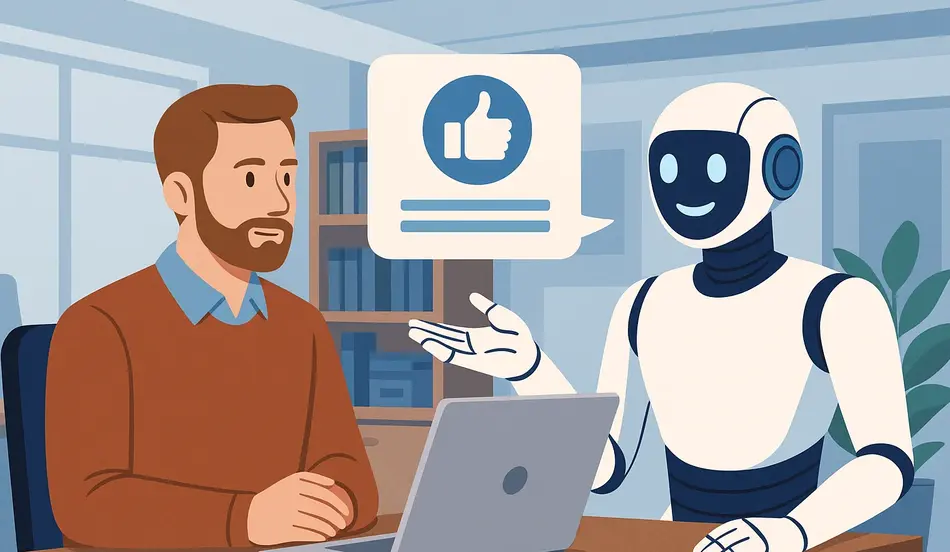The Death of Traditional Employee Surveys: AI Digital Coworkers Take Center Stage
If you’ve ever worked in an office environment, you’re likely familiar with the tedious ritual of completing employee satisfaction surveys. These traditional feedback mechanisms—rating your workplace experience on a 1 to 5 scale—have long been a source of frustration for employees and employers alike. Employees find them time-consuming and often doubt whether their input makes any difference, while employers struggle to extract actionable insights from standardized responses.
Enter the era of AI digital coworkers—sophisticated artificial intelligence systems designed to revolutionize how companies gather, process, and act on employee feedback. These intelligent systems are rapidly replacing traditional surveys with interactive, conversation-based approaches that promise to transform workplace communication and culture.
According to recent reports, multiple Fortune 500 companies have already implemented these AI digital coworkers, with early adopters reporting significant improvements in workplace culture and employee retention rates. This technological shift represents a fundamental change in how organizations understand and respond to their employees’ needs and concerns.
Table of Contents
How AI Digital Coworkers Function: Beyond Simple Surveys
Traditional employee surveys suffer from numerous limitations: they’re rigid, infrequent, and often fail to capture the nuanced reality of workplace experiences. AI digital coworkers address these shortcomings through a fundamentally different approach to gathering feedback.
The Interactive Experience: Conversations Instead of Forms
Rather than asking employees to complete standardized forms, AI digital coworkers engage them in what feels like a video conference. Selected participants receive an email invitation to join a session with an AI agent designed to listen, respond, and adapt based on their input.
“The participants you’ve selected, they get an email and they jump into what feels a bit like a video conference with this AI agent,” explains a representative from Arthur Technologies, the company behind a leading AI digital coworker platform called Vibe.
This conversational format creates a more natural and engaging experience, encouraging employees to share their thoughts more openly and thoroughly than they might in a traditional survey format.
Adaptive Intelligence: Personalized Follow-Up Questions
Unlike static surveys, AI digital coworkers can dynamically adjust their questions based on an employee’s responses. This adaptive capability allows the system to explore topics in greater depth and pursue relevant lines of inquiry that might not have been anticipated in a pre-designed questionnaire.
“You have an intelligent counterpart that can actually ask a follow-up question, drill a bit deeper, really understand what you’re talking about, and then relay this information properly,” notes an industry expert familiar with the technology.
This ability to probe beyond surface-level responses enables companies to uncover underlying issues and opportunities that might otherwise remain hidden in traditional feedback processes.
Learn more about conversational AI technology
The Business Impact of AI Digital Coworkers
The adoption of AI digital coworkers for employee feedback is more than just a technological novelty—it represents a strategic advantage for organizations seeking to improve their workplace culture and operational effectiveness.
Enhanced Employee Voice and Representation
One of the primary benefits of AI digital coworkers is their ability to ensure that all employees have a voice within the organization. Traditional survey methods often fail to capture the perspectives of quieter team members or those who feel their opinions won’t make a difference.
AI digital coworkers are designed specifically to address this challenge. As Arthur Technologies explains, their Vibe platform aims to “make sure all employees have a voice and don’t get lost in the crowd.” By creating a more personal and responsive feedback channel, these systems can draw out insights from employees who might otherwise remain silent.
This more inclusive approach to gathering feedback can help organizations identify blind spots in their policies and practices, leading to more equitable and effective workplace environments.
Actionable Insights for Leadership
Perhaps the most significant advantage of AI digital coworkers is their ability to transform raw feedback into actionable insights. Traditional surveys often generate large volumes of data that can be difficult to interpret and translate into concrete actions.
AI digital coworkers address this challenge by:
- Identifying patterns and trends across numerous conversations
- Highlighting urgent issues that require immediate attention
- Categorizing feedback into actionable themes
- Providing context and nuance that might be missed in numerical ratings
- Suggesting potential solutions based on employee input
These capabilities enable leadership teams to make more informed decisions about workplace policies, team structures, and organizational culture.
Measurable Improvements in Retention and Culture
Early adopters of AI digital coworkers report significant benefits in terms of employee retention and workplace culture. By creating more effective feedback channels and acting on the insights they generate, organizations can address issues before they lead to employee departures.
“Early reports show it is resulting in a healthier workplace culture and better employee retention,” notes an observer of the technology’s implementation at Fortune 500 companies.
In an era where talent acquisition and retention represent major challenges for many organizations, these improvements can translate directly to bottom-line benefits through reduced recruitment costs and preserved institutional knowledge.
Explore how AI is transforming HR practices
The Future of Human-AI Collaboration in the Workplace
The emergence of AI digital coworkers for employee feedback represents just one facet of a broader trend toward human-AI collaboration in workplace settings. Rather than replacing human workers, these technologies aim to enhance human capabilities and improve communication.
Amplifying Voices Rather Than Replacing Jobs
While discussions about AI often focus on job displacement, AI digital coworkers exemplify how the technology can instead enhance human communication and decision-making.
“We talk a lot about how AI takes our jobs away, but if we look at amplifying voices or augmenting human communication, it actually becomes an incredible force for good,” explains a technology expert involved in developing these systems.
This perspective aligns with research suggesting that the most effective AI implementations are those that complement human skills rather than attempting to replace them entirely.
Expanding Applications Beyond Feedback
The success of AI digital coworkers in the feedback space points to potential applications in other areas of workplace communication and collaboration:
- Onboarding and training – AI agents that can guide new employees through company processes and answer questions in real-time
- Conflict resolution – Neutral AI mediators that can help address interpersonal issues before they escalate
- Knowledge management – AI systems that can capture and distribute institutional knowledge more effectively
- Meeting facilitation – AI assistants that ensure all participants have opportunities to contribute
- Wellness support – AI companions that check in on employee well-being and provide resources as needed
These potential applications suggest that AI digital coworkers could become integral parts of workplace ecosystems, serving as bridges between human team members and enhancing organizational communication at multiple levels.
Find AI-related jobs in your area
Implementation Challenges and Considerations
Despite their potential benefits, implementing AI digital coworkers involves several important considerations that organizations must address to ensure success.
Privacy and Trust Concerns
For AI digital coworkers to function effectively, employees must trust the system and feel comfortable sharing their honest thoughts and concerns. This requires clear communication about:
- How employee data is collected, stored, and used
- Who has access to individual responses versus aggregated insights
- What safeguards are in place to protect sensitive information
- How the organization will act on the feedback received
- The boundaries of what the AI can and cannot do with employee information
Organizations that fail to address these concerns may find employees reluctant to engage meaningfully with AI digital coworkers, limiting the system’s effectiveness.
Integration with Existing HR Processes
To maximize their impact, AI digital coworkers must be thoughtfully integrated with existing human resources processes and systems. This integration should ensure that:
- Insights generated by AI digital coworkers inform broader HR strategies
- Actions taken based on AI-gathered feedback are communicated back to employees
- The AI system complements rather than competes with human HR professionals
- Feedback gathered through multiple channels is considered holistically
- The implementation aligns with the organization’s overall people strategy
Effective integration requires collaboration between technology teams, HR professionals, and organizational leadership to ensure alignment with broader business objectives.
Hiring?
Connect With AI-Savvy Talent to Implement Digital Coworker Solutions
Looking to introduce AI digital coworkers to your organization? Find qualified professionals with expertise in artificial intelligence, employee experience, and organizational development to guide your implementation.
🤖 Post Jobs for Free with WhatJobsThe Broader Context: AI Digital Coworkers and Workplace Evolution
The adoption of AI digital coworkers for employee feedback reflects broader trends in how organizations are evolving to meet changing workplace expectations and technological possibilities.
The Growing Importance of Employee Experience
According to Pew Research, approximately half of all American workers consider workplace culture and employee experience when evaluating job opportunities. This statistic underscores the strategic importance of effective feedback mechanisms like AI digital coworkers.
Organizations that can accurately understand and respond to employee needs gain significant advantages in terms of:
- Attracting top talent in competitive markets
- Retaining valuable team members during challenging periods
- Building cultures that support innovation and collaboration
- Adapting quickly to changing market conditions
- Maintaining employee engagement during periods of organizational change
AI digital coworkers provide a sophisticated tool for organizations seeking to excel in these areas by creating more responsive and adaptive workplace environments.
The Evolution of Workplace Communication
The shift from traditional surveys to AI digital coworkers represents part of a broader evolution in workplace communication. As organizations become more distributed and digital, new tools and approaches are needed to maintain effective communication across teams and hierarchies.
AI digital coworkers offer several advantages in this evolving landscape:
- They can operate across time zones and geographic boundaries
- They provide consistent experiences regardless of location or department
- They can process and synthesize large volumes of communication
- They offer scalable solutions for organizations of varying sizes
- They can adapt to different communication styles and preferences
These capabilities position AI digital coworkers as valuable assets for organizations navigating the complexities of modern workplace communication.
Measuring Success: KPIs for AI Digital Coworker Implementation
For organizations considering the implementation of AI digital coworkers, establishing clear key performance indicators (KPIs) is essential for evaluating success and guiding ongoing refinement.
Quantitative and Qualitative Metrics
Effective measurement of AI digital coworker impact should include both quantitative and qualitative metrics:
- Participation rates – Percentage of employees engaging with the AI system compared to traditional surveys
- Insight generation – Number and quality of actionable insights produced
- Issue resolution – Time from feedback collection to problem resolution
- Employee retention – Changes in turnover rates following implementation
- Culture indicators – Improvements in established culture and engagement metrics
By tracking these indicators over time, organizations can assess the return on their investment in AI digital coworker technology and identify opportunities for enhancement.
FAQ: Understanding AI Digital Coworkers
What exactly are AI digital coworkers and how do they differ from traditional employee surveys?
AI digital coworkers are intelligent systems that replace traditional employee surveys with interactive, conversation-based approaches to gathering feedback. Unlike static surveys with predetermined questions and rating scales, AI digital coworkers engage employees in dynamic conversations that feel similar to video conferences. These AI systems can ask follow-up questions, drill deeper into specific topics, and adapt in real-time based on employee responses. This conversational approach allows for more nuanced feedback collection and helps ensure that employee concerns are properly understood and communicated to management, resulting in more actionable insights than traditional survey methods.
How do AI digital coworkers benefit both employees and employers?
AI digital coworkers create significant benefits for both employees and employers in the feedback process. For employees, these systems provide a more engaging experience that feels like their individual voice matters, rather than just being another number in a survey dataset. The conversational format allows employees to express their thoughts more naturally and thoroughly, while the AI’s ability to ask relevant follow-up questions helps ensure their concerns are fully understood. For employers, AI digital coworkers generate more actionable insights by identifying patterns across conversations, highlighting urgent issues, and providing context that might be missed in numerical ratings. Early adopters report improvements in workplace culture and employee retention, demonstrating tangible business benefits from this technology.
Are there privacy concerns with AI digital coworkers collecting employee feedback?
Privacy considerations are indeed important when implementing AI digital coworkers for feedback collection. For these systems to function effectively, employees must trust that their honest feedback won’t lead to negative consequences. Organizations implementing AI digital coworkers need to clearly communicate how employee data is collected, stored, and used, including who has access to individual responses versus aggregated insights. Successful implementations typically include robust data protection policies, transparent communication about how feedback influences decisions, and clear boundaries regarding what the AI can and cannot do with employee information. Without addressing these privacy concerns, organizations risk low participation rates and superficial feedback that limits the system’s effectiveness.
How will AI digital coworkers evolve in the future workplace?
The future evolution of AI digital coworkers will likely expand beyond feedback collection into other areas of workplace communication and collaboration. As these systems become more sophisticated, we can expect applications in onboarding and training, where AI agents guide new employees through company processes; conflict resolution, with neutral AI mediators helping address interpersonal issues; knowledge management, capturing and distributing institutional wisdom; meeting facilitation, ensuring all participants have opportunities to contribute; and wellness support, with AI companions checking on employee well-being. Rather than replacing human workers, these technologies will increasingly focus on enhancing human capabilities and improving communication across organizations, serving as bridges between team members and augmenting organizational effectiveness at multiple levels.




